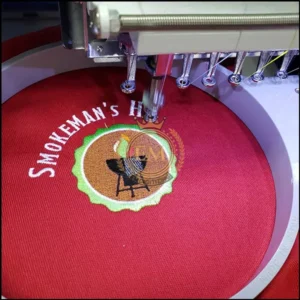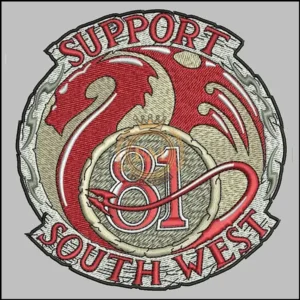Die Digitalisierung der Logos für Stickerei ist zu einem wesentlichen Prozess in der Welt der Textildekoration geworden. Mit technologischen Fortschritten, Die traditionelle manuelle Methode zur Replikation von Logos durch Sticken wurde durch Digitalisierung ersetzt.

Emdigitation ist das Unternehmen für alle Ihre Digitalisierungsbedürfnisse Ihrer Stickerei-Logo. Wir haben ein Team qualifizierter Stick-Logo-Digitalisierer, die zusammenarbeiten, um sicherzustellen, dass Sie qualitativ hochwertige Ergebnisse zu einem erschwinglichen Preis erhalten. Nehmen Sie noch heute Kontakt mit uns auf.
Dieser Artikel wird die Vorteile von untersuchen Digitalisierung für Stickerei. Durch Verständnis der Vorteile von Logos digitalisieren, Unternehmen, Und Einzelpersonen können die besten Stickergebnisse erzielen und gleichzeitig mit den Anforderungen des modernen Marktes Schritt halten.
Vorteile der Digitalisierung von Logos für optimale Stickergebnisse
Vorteile der Digitalisierung von Logos für Stickereien
Sprechen wir über die Vorteile der Logo -Digitalisierung:
1. Präzision in der Logo -Digitalisierung
Digitalisierende Logos stellt sicher, dass Sie ein knackiges und detailliertes Logo -Design erhalten. Vom kleinsten Text bis zu den besten Zeilen, Der Digitalisierungsprozess stellt sicher, dass Ihr Logo mit äußerster Präzision auf Stoff übersetzt wird. No more blurry or distorted images –; Ihr Logo wird klar und scharf sein.
2. Genaue Farbdarstellung
Farben spielen eine wichtige Rolle beim Branding, Und Sie möchten, dass Ihr Logo genau dargestellt wird. Mit Digitalisierung, Die Farben in Ihrem Logo sind genau abgestimmt, Stellen Sie sicher, dass die gestickte Version dem ursprünglichen Design treu bleibt.

Verabschieden Sie sich von nicht übereinstimmenden Farbtönen oder verblassten Tönen von Ihnen Markenfarben.
3. Qualitätslogo -Nähte
Digitalisierung von Logos ist ein entscheidender Schritt in Richtung Erzielung hochwertiger Stickergebnisse erzielen. Es legt die Grundlage für makellose Ausführung und detaillierte Reproduktion Ihres Logos.
Durch Investition in den Digitalisierungsprozess, Sie können sicherstellen, dass das endgültige gestickte Produkt Ihre Erwartungen in Bezug auf Qualität entspricht, Präzision, und visuelle Wirkung.
4. Abnäherungsstichverzerrungen beseitigen
Eine der größten Herausforderungen bei der Stickerei besteht darin. Digitalisierende Logos hilft dabei.

Dies bedeutet, dass selbst komplexe Entwürfe treu reproduziert werden können, Ohne wackelige Linien oder ungleiche Stiche. Ihr Logo sieht jedes Mal makellos aus.
5. Reduzierte Produktionszeit
Die Digitalisierung der Logos beschleunigt den Produktionsprozess, indem es zulässig ist Stickmaschinen effizient arbeiten.
Mit dem Digitale Dateianleitung die Maschine, there’;S benötigen keine manuellen Anpassungen und Vermutungen. Dies bedeutet schnellere Wendezeiten, Besonders für große Bestellungen oder komplizierte Designs.
6. Vereinfachte Logo -Reproduktion
Wenn Sie Ihr Logo auf verschiedenen Artikeln oder Kleidungsstücken replizieren müssen, Digitalisierende Logos macht den Prozess zum Kinderspiel.

Sobald die digitale Datei erstellt wurde, Es kann leicht so eingestellt werden, dass es an verschiedene Größen anpasst, und stickt auf verschiedene Materialien. Diese Vielseitigkeit spart Zeit und Mühe, Ermöglichen Sie, dass Sie Ihr Logo mühelos auf verschiedenen Artikeln präsentieren.
7. Logo -Größen- und Skalierung
Einer der größten Vorteile der Digitalisierung von Logos für die Stickerei ist die Fähigkeit zu Größe und Skalierung sie ohne Details oder Qualität zu verlieren.
Egal, ob Sie ein kleines Logo für einen Hut oder einen größeren für eine Jacke benötigen, digitization ensures that your logo doesn’;Ich verliere seine Klarheit oder Schärfe.
8. Verringerte Arbeitskosten
Durch Digitalisierung von Logos, Sie können auch die Arbeitskosten senken. Traditionelle Stickmethoden erfordern oft erfahrene Handwerker, um das Design von Hand sorgfältig zu verfolgen.
Die Digitalisierung vereinfacht diesen Prozess, Reduzierung der Notwendigkeit von erfahrenen Arbeitskräften. Dies bedeutet, dass Sie Ihre Ressourcen effizienter zuweisen und möglicherweise die Kosten senken können, Ermöglichen Sie, dass Sie Ihren Kunden wettbewerbsfähige Preise anbieten.
9. Konsistenz in der Logo -Replikation
Konsistenz ist der Schlüssel, wenn es um Branding geht. Digitalisierende Logos stellt sicher, dass jede Stickproduktion Ihres Logos konsistent ist, Form, und Platzierung.
Keine Sorge mehr über Abweichungen zwischen verschiedenen Teilen oder Chargen. Ihr Logo sieht über alle Ihre gestickten Gegenstände einheitlich aus, Aufrechterhaltung einer zusammenhängenden Markenidentität.
10. Präzise Nähte
Digitalisierte Logos ermöglichen eine präzise und fachkundige Stitching -Platzierung. Jeder Stich ist akribisch geplant und ausgeführt, was zu einem Logo führt, das auffällt und ins Auge fällt.

Verabschieden Sie sich von falsch ausgerichteten oder ungleichmäßigen Stickereien. Mit Digitalisierung, Ihr Logo wird fehlerfrei genäht sein, Erstellen eines polierten und professionellen Finishs, das Ihre Marke zu neuen Höhen erhöht.
Fazit: Verbesserung der Stickerei mit digitalisierten Logos
Die Digitalisierung von Logos kann einen großen Einfluss auf Unternehmen aller Größen haben. Es kann auch dazu beitragen, Stickergebnisse zu verbessern. Wenn Sie Ihre wollen Logo-Digitalisierungsdienste, Wir können Ihnen helfen!
We offer embroidery digitizing and vector art services that can enhance your business reputation in today’;Der sich ständig weiterentwickelnde Markt.
If you’;Ich bin zum ersten Mal Kunde, Wir haben ein besonderes Angebot nur für Sie! Du kannst bekommen 50% Profitieren Sie von allen unseren Dienstleistungen und erwarten Sie die besten Ergebnisse. Wir bieten auch a kostenloses Angebot, was nur dauert 5 Minuten zu generieren.
Warum also warten?? Nehmen Sie noch heute Kontakt mit uns auf!
Wenn Sie diesen Artikel hilfreich fanden, don’;Vergessen Sie nicht, es mit Ihren Freunden zu teilen. Wir ermutigen Sie auch, Ihre Gedanken mit uns zu teilen. We’;Ich würde gerne hören, was Sie über dieses Thema denken!
Danke fürs Lesen!
Häufig gestellte Fragen:
Die Digitalisierung von Stickereien verwandelt Kunstwerke in eine digitale Datei, die Stickmaschinen lesen können, Aktivieren Sie komplizierte und präzise Designs auf Stoff. Dieser Prozess verbessert die Designqualität, ermöglicht die Massenproduktion, und bietet Flexibilität bei der Änderung von Designs.
Digitalisiert ein Logo zur Stick. Dieser Prozess stellt sicher, dass das Logo genau und effizient auf verschiedene Materialien gestickt werden kann.
Ein Logo digitalisiert zu haben bedeutet, das Logo in ein für Stickerei geeignetes Format umzuwandeln, Ermöglichen Sie eine konsistente und qualitativ hochwertige Reproduktion des Logos auf Kleidungsstücken und anderen Textilien.
Die Funktion einer Digitalisierungsmaschine besteht darin, digitale Stickdateien zu lesen und sie zu verwenden, um den Stickprozess zu leiten, Gewährleistung einer präzisen Stichplatz- und Musterreplikation auf dem Stoff.
Zu den Vorteilen der Digitalisierung gehört eine erhöhte Effizienz, Verbesserte Zugänglichkeit von Informationen, Verbesserte Datenanalysefunktionen, und die Erhaltung von Dokumenten und Aufzeichnungen in einem dauerhaften, digitales Format.
Die Digitalisierung bezieht sich auf den Prozess der Konvertierung von Informationen in ein digitales Format. Zu den Vorteilen gehören das einfachere Teilen und die Speicherung von Daten, Schnelle Datenverarbeitung, und die Fähigkeit, verschiedene Prozesse zu automatisieren und zu integrieren.
